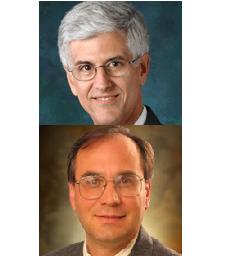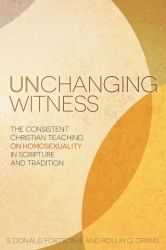Today we continue the very informative interview with Don Fortson and Rollin Grams, as they talk to us about their new and important book, Unchanging Witness. If you missed Part 1 of the interview last week, you can catch up here.
Books At a Glance:
Let’s ask the question in broadest scope possible: From the Old Testament to the first-century Jews to the New Testament to the early centuries of the church, the Middle Ages, the Reformation, and beyond, is there any appreciable difference in the church’s judgment regarding homosexuality.
Fortson & Grams:
[Grams] What we find in the Old Testament is unique for the Ancient Near Eastern context: homosexual acts without qualification where condemned. Judaism continued to follow Old Testament teaching, and in this Christians held to the same view over against the Greek and Roman context. That is, people who took their ethics from the Scriptures, whether the Old Testament alone or both the Old and New Testaments, lived against the grain of their cultures on the issue of homosexuality and, for that matter, an array of other sexual practices. And so said the Church all the way up until our lifetime. It still does, for that matter, except in the few, rapidly declining, mainline denominations in the West that have embraced their post-Christian culture and opposed Biblical authority for the faith.
Books At a Glance:
What about in contexts where homosexual practice was more prevalent?
Fortson & Grams:
[Grams] This is an important point. Had Jews and Christians opposed homosexual practice in contexts that also opposed them, one might ask the question whether their views were introduced from their cultures. Homosexuality was a practice in Mesopotamia, Egypt, and Canaan, and it was a practice in the Greek and Roman world. Even as the Church relaxed certain Old Testament Laws that brought a division between Jews and Gentiles, such as food laws, circumcision, and observance of special Jewish holy days, they re-affirmed the sexual ethic of the Old Testament, including homosexual practice and gender confusion, over against culture.
Books At a Glance:
Was there such an idea as sexual “orientation” in the ancient world?
Fortson & Grams:
[Grams] Absolutely. One of the grand myths of a pocket of modern scholarship was that there was no perspective on orientation in antiquity. We demonstrate that a variety of views on sexual orientation were floated in antiquity. In fact, the larger question of whether people do what they do because of nature or nurture was a major topic in Greek philosophy. We think that our discussion of these issues over several chapters makes a contribution to the question of sexual orientation in antiquity—and in the New Testament.
Books At a Glance:
You emphasize that “The Old Testament is not a collection of unrelated laws against sexual sin. It articulates an overall understanding of the place for sex” (p.201). Explain your point here for us.
Fortson & Grams:
[Grams] The first century Jewish historian, Josephus, offers an explanation of Jewish views on sex, showing that he believed that there was such a thing as what we would call a sexual ethic. Yet some, such as Walter Wink and Jack Rogers, have claimed that there is no Biblical sexual ethic. That claim rejects the idea that the various moral teachings on sex in Scripture is not consistent and cannot be united into a single ethic. Josephus would disagree—and so would we.In fact, the very reason that New Testament authors can use general terms for sexual sin is that the churches had a clear understanding of what that sexual ethic was. The probable reason for why Jesus does not address the topic of homosexuality, as he does the issue of divorce and remarriage, is that the former issue simply was not an issue in Israel. The latter issue was. And the fact that churches in the Gentile context needed teaching and correction on sexual ethics is precisely because they had to be taught that Scripture contradicted their culture in the area of sexuality, including the issue of homosexuality.
As to there being an overall understanding of the place for sex, Scripture as a whole teaches that this is in marriage between a man and a woman—no surprise there, except for the revisionist readings in our day.
Books At a Glance:
Talk to us about the alleged parallel between issues of ethnicity, gender, and sexual orientation in the Bible. What is the claim, and what are the problems you find with it.
Fortson & Grams:
[Grams] In the West, ethics in general has long been and still is approached with ‘thin principles,’ as Glen Stassen (an ethicist who taught at Fuller Theological Seminary) used to say. The key thin principle is ‘freedom.’ The American narrative, for example, is weaved from the threads of the ideals of freedom and equality in particular: freedom from religious oppression, freedom from political oppression (England), freedom for slaves, freedom and equality for women to vote, freedom to limit family size through contraception, freedom to divorce and remarry, sexual freedom, freedom for blacks through civil rights, freedom of choice for women to have abortions, and now, the argument goes, freedom for homosexuals in society, including to ‘marry.’This American narrative, closely paralleling the European narrative as well, as flawed as it is, gives rise to our present culture of political correctness. It creates a certain hermeneutic for our culture and explains why those not grounded in the faith either find the pro-homosexual agenda so obviously compelling or are left bereft of counter-arguments. We address this matter to some extent in our book, although it deserves a more extensive answer. Many blacks find it insulting to link their narrative of civil rights with the push for sexual license. Paul emphasizes racial, gender, and economic equality in Christ while he opposes sexual license, including homosexuality.
The argument for slavery in the 19th century may have appealed to Scripture, but only in ignorance of the text and its right interpretation. More significantly, they were interpreting the text in light of their cultural situation: the use of Scripture for slavery parallels the use of Scripture for homosexual practice in that both are culturally influenced interpretations that ignore good exegesis. As to the issue of the role and status of women, we simply point out that there have been various views and practices in history—even in Biblical times—on this issue, unlike the issue addressed in our book.
[Fortson] I would add on the 19th C. American slavery issue that Christians were the key leaders of the abolition movement. Pro-slavery views in this era were race based, something to which Scripture is diametrically opposed – which accounts for why so many believers never bought into the pro-slavery propaganda used to prop up an economy dependent on keeping one race in bondage.It is noteworthy that much of today’s rhetoric about gay rights is also economically driven – corporate America has caved on the issue in part because of the economic ramifications of supporting traditional marriage in a culture of irrational outrage against anything that violates political correctness. Scripture is clear that both slave-trading and homosexuality are sinful in the sight of God, and St. Paul lists them both in 1 Timothy 1:10 as “contrary to sound teaching.”
Books At a Glance:
You mention that “effeminacy” was condemned in ancient Israel also. Just what is “effeminacy”? What does it entail?
Fortson & Grams:
[Grams] Actually, both the Old Testament and the New Testament address the issue of dress with respect to gender. The simplest answer to your question is that effeminate dress for males or masculine dress for women is opposed in Scripture. Gender is not an issue of how one perceives oneself despite ones sexuality; it is one’s sexuality, determined by biological make-up.One might have an orientation that goes against one’s biologically determined gender, and just here we need to understand that Scripture—from beginning to end—sees humanity as driven by sinful orientations. What we read of the generation of Noah’s day is actually true of all humanity: ‘And God saw that the earth was corrupt; for all flesh had corrupted its ways upon the earth’ (Gen. 6.12). What is ‘natural’ is not what one thinks or how one feels but how God has made us. While we come close to agreeing with several other scholars on the meaning of ‘soft men’ in 1 Cor. 6.9, we may have contributed something to the discussion of the primary sources here.
The term referred to males living a ‘soft’ life, and this included those identifying themselves (an orientation) in effeminate ways and engaging in homosexual acts. We have some very graphic descriptions of this from antiquity, and they would not surprise us today. Effeminate males would dress as women, smooth their bodies, wear make-up, have long hair, talk a certain way, walk a certain way, and so on. Paul says to the Corinthian church that ‘such were some of you.’ Then he notes that they have been transformed through the work of Christ and the Holy Spirit (1 Cor. 6.11).

